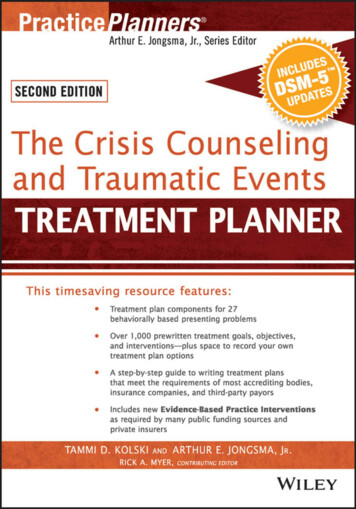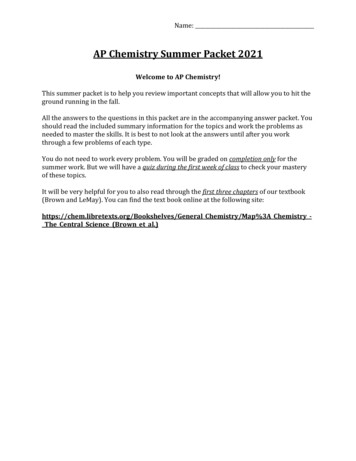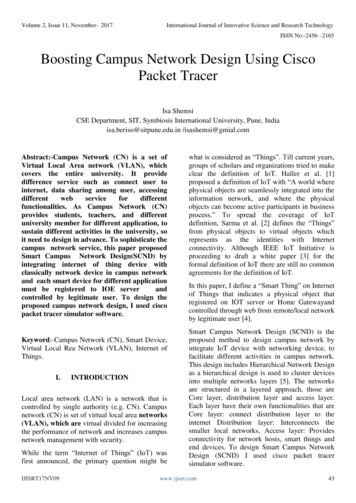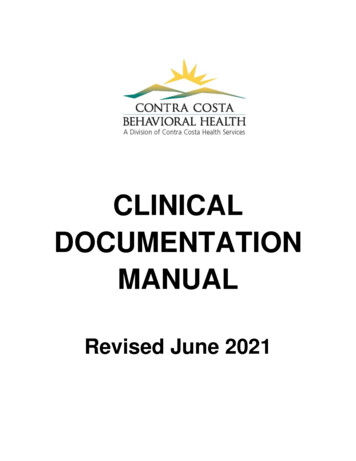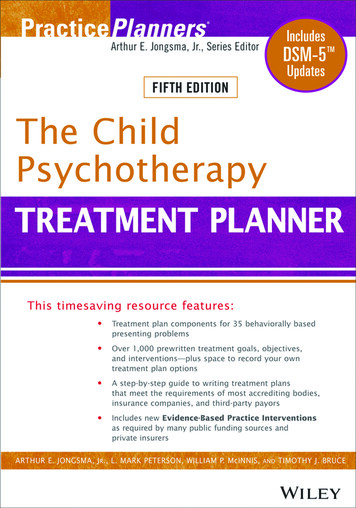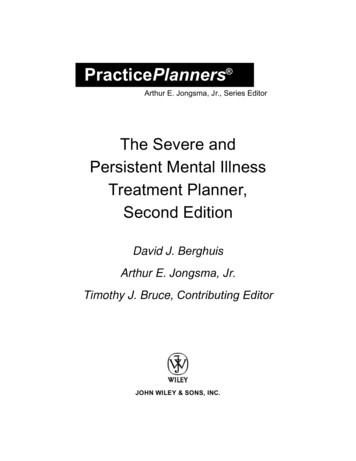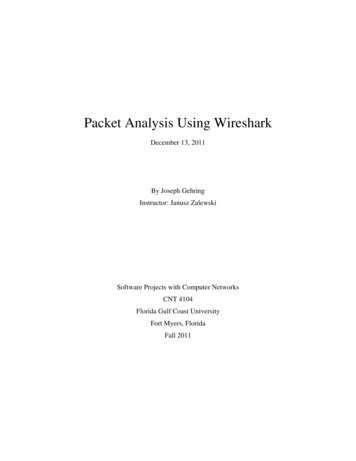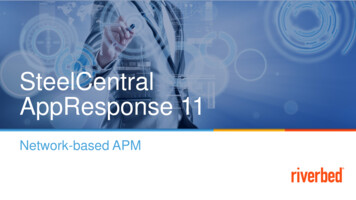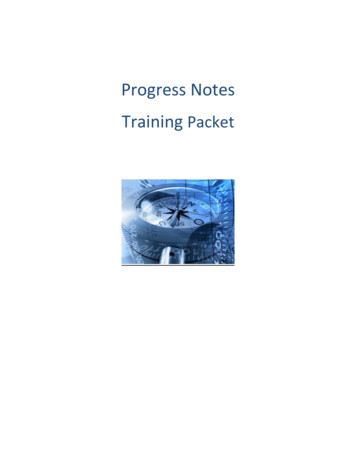
Transcription
Progress NotesTraining Packet
Service TypesCase Management [541, 561, 571]“Targeted Case Management” (Case Management/ Brokerage/Linkage/Placement) means services that assista client to access needed medical, educational, social, pre‐vocational, vocational, rehabilitative, or othercommunity services. The service activities may include, but are not limited to, communication, coordination,and referral; monitoring service delivery to ensure client access to service and the service delivery system;monitoring of the client’s progress; placement services; and plan development.*“Intensive Care Coordination” (Targeted Case Management for Katie A clients) means facilitatingassessment of, care planning for and coordination of services, including urgent services. Includesassessment related to action planning and development/revision of action plans, referral, linkage,monitoring and transition activities that address the use of natural and community supports.“Collateral” means a service activity to a significant support person in a client’s life with the intent ofimproving or maintaining the mental health status of the client. The client may or may not be present for thisservice activity.Rehabilitation [317, 318, 355]“Rehabilitation” means a service activity which includes assistance in improving, maintaining, or restoring aclient’s or group of clients’ functional skills, daily living skills, social and leisure skills, grooming and personalhygiene skills, meal preparation skills, and support resources; and/or medication education.*“In Home Behavioral Support” (Mental Health Rehabilitation Services for Katie A clients) meansintensive, individualized, strength‐based interventions designed to ameliorate mental healthconditions that interfere with functioning and assist in building skills and developing replacementbehaviors necessary for success at home and in the community.“Assessment” means a service activity which may include a clinical analysis of the history and current status ofa client’s mental, emotional, or behavioral disorder; relevant cultural issues and history; diagnosis; and the useof testing procedures.“Plan Development” means a service activity which consists of development of client plans, approval of clientplans, and/or monitoring of a client’s progress.“Therapy” means a service activity which is a therapeutic intervention that focuses primarily on symptomreduction as a means to improve functional impairments. Therapy may be delivered to an individual or groupof clients and may include family therapy.“Medication Support Services” means those services which include prescribing, administering, dispensing andmonitoring of psychiatric medications or biologicals which are necessary to alleviate the symptoms of mentalillness. The services may include evaluation of the need for medication, evaluation of clinical effectiveness andside effects, the obtaining of informed consent, medication education and plan development related to thedelivery of the service and/or assessment of the client.Crisis Intervention [371]“Crisis Intervention” means a service, lasting less than 24 hours, to or on behalf of a client for a conditionwhich requires more timely response than a regularly scheduled visit. Service activities may include but arenot limited to assessment, collateral and therapy. Crisis intervention is distinguished from crisis stabilization bybeing delivered by providers who are not eligible to deliver crisis stabilization or who are eligible, but deliverthe service at a site other than a provider site that has been certified by the department or a Mental HealthPlan to provide crisis stabilization.351*]2 Page5/2/2018
(Note: To be reimbursable, service components must also meet Medical Necessity)Medi-Cal, SMHS (Specialty Mental Health Services)Service Component ExamplesActivity that IS a Service ComponentRefer and coordinate client’s registration with the local youth center inorder to increase client’s socialization with peers.Coached client on how to figure out a monthly budget on her own, whileaccompanying her to the bank.Primary Therapist spoke with Clinician who facilitates the ongoingDepression Group that client attends to get an update on how client’s doingin group.Model effective communication skills for client during community outing tothe park.Speak with client at graduation venue prior to ceremony about the gainsshe’s made throughout her treatment as part of the therapeutic terminationprocess.At the market, led client in practicing the steps involved in obtaininggroceries for himself.Meet with client’s Foster Mom to teach her how the behavior chart worksand help her to practice implementing it for client.Assist client with employing relaxation techniques to help reduce anxietywhile utilizing public transportation.Administer psychological tests to evaluate whether client’s behavioralsymptoms are due to mental illness or are more organic in nature.Facilitated current events group, assisting clients with increasing their focuson external stimuli and verbal interaction with others.Complete a community college verification of disability form to assist clientin getting back into school and resuming his education based on a TCMevaluation.Demonstrate different relaxation techniques and how they might benefitclient helping to reduce his anxiety.Redirect client from verbally abusive language toward another client duringgroup and facilitate insight oriented discussion regarding the impact of theabusive language.Department of Mental Health – Quality Assurance UnitServiceComponentReferral and RelatedActivitiesRehabilitationPlan vity that IS NOT a Service ComponentProvide client with a list of TAY activity centers to call andlook into.Transport client to the bank to deposit her check.Spoke with referring Primary Care Physician to inform himthat client was evaluated and does not meet criteria for thisprogram.Take clients to the park for exercise.Attend client’s high school graduation.Go grocery shopping with client.RehabilitationHave breakfast with client’s mother to build a rapport withher.Accompany client to her DPSS appointment using publictransportation.Provide monthly report to DCFS per their request onclient’s mental status.Talk to client about current events.Referral and RelatedActivitiesComplete client’s application for Social Security benefitsbased on a request from DPSS.CollateralRehabilitationAssessment (MHS)RehabilitationResearch different relaxation techniques for clients.TherapyRemind client of the no profanity rule during group.For Training Purposes OnlyLast Revised 07/20/2020
Targeted Case Management vs. RehabilitationTCM (T1017)Service Components: Assessment Plan Development Referral and Related Activities Monitoring and Follow-upWhat it is: Services to assist client in accessing needed ancillary services (i.e.medical, dental, alcohol/drug treatment, educational, social,prevocational, rehabilitative, or other community services) Services include linkage and consultation, placement, and plandevelopmentRequirements: Justify need for TCM service based on the client’s mental healthsymptoms/impairments Evaluating for needs, planning, referral, and progress Assisting client in gaining access to services and plan coordination whenlinking client to services and monitoring progress Ensuring TCM services are being furnished in accordance with clienttreatment plan Evaluating the adequacy of services/resources and adjusting planaccordinglyRehabilitation (H2015)A Component of Mental Health Services: Assessment Plan Development Therapy Rehabilitation CollateralWhat it is: A service delivered to a client to provide assistance in improving,maintaining, or restoring the client’s functional, daily living, social andleisure, grooming and personal hygiene, or meal preparation skills, orhis/her support resources Service activity provides assistance in restoring, improving, and/orpreserving a client’s functional, social, communication, or daily livingskills to enhance self-sufficiency or self-regulationRequirements: Must provide assistance in restoring, improving, or preserving theclient’s functional level (i.e. skill building) Focus should be on teaching skills, not doing the skill/activity for theclientTCM activities: Locating and securing appropriate resources Monitoring the client’s access to services Monitoring the client’s progress once access has been establishedRehab activities: Teaching the client social skills/communication skills/problem-solvingskills/relaxation skills/anger management skills/assertiveness skills topromote self-sufficiency Prompted the client to use healthy coping skill (e.g. deep breathing) toself-regulate while doing an activityKey words when writing TCM note:Refer to Active Verbs/Phrases that Can Be Used to Document Targeted CaseManagement (TCM) Service InterventionsKey words when writing a Rehab note:Refer to section on Rehabilitation in Active Verbs/Phrases that Can Be Used toDocument Mental Health Services (MHS) InterventionsDepartment of Mental Health – Quality Assurance UnitFor Training Purposes OnlyLast Revised 07/20/2020
Intervention Phrase Examples acknowledged client’s need for improvement in actively listenedallowed client to openly expressasked client to be mindful ofasked exploratory, Socratic, open‐ended, directed, feelings‐related questions regardingassessed client’s mood by asking questions related to/aboutassisted client inbrought to client’s attentionchecked in with clientclarified the expectations for; asked for clarification aroundcollaborated on/withcongratulated clientcontinually checked for appropriateness duringdemonstrated patience around.directed the clientdiscussed client’s current behavior, coping skills, triggers, treatment planempathized withencouraged client to express/use mindfulness/make alternative behavioral choicesaboutengaged in a feelings‐related conversationestablished clear boundariesexplicitly stated and had client repeat for clarityexplored client’s underlying feelings aboutexpressed concern/cautioned about client’s words/actions/behaviorsfacilitated a conflict resolution/conversation betweenfollowed up with/onfrequently checked back with client for the duration of the activity forgranted client’s request guided the client in a role play/ role‐played the situation so that client could experiencedifferent outcomeshelped client achieve goal # by; create a behavioral contractidentified triggers, coping skills, boundaries informedinitially used planned ignoring so as not to positively reinforce the negative behavior butthen isolated/insulated client from the situation and used active listening tomade plans for client’s next interactionmodeled various reactions to3 Page5/2/2018
Additional Intervention Phrases That Specifically Support the Core Practice Model 4 PageIdentified and encouraged replacement behaviors such as Provided psycho‐education about Aimed at reducing symptoms including Created behavior plans about/for the purpose of Developed functional skills such as to address impairment(s) including Provided collateral consultation to about .Worked within a child and family centered frameworkReaches out to informal supportsDemonstrates cultural competencyPromotes permanency and stabilitySafetyPromotes well‐beingTeamingFamily voiceChild and Family TeamCare CoordinationIndividualizedStrengths BasedSustainabilityPermanencyConnectednessFamily FocusedCulturally RespectfulNeeds drivenSkills buildingBuild trustEncourage transparency5/2/2018
ACTIVE VERBS/PHRASES THAT CAN BE USED TO DOCUMENTINTENSIVE HOME BASED SERVICES (IHBS) INTERVENTIONS*This is not an exhaustive listRehabilitation:Assisted client with restoring/improving/preservingfunctioning in (communication, daily living, etc.) by Assist client with acquiring and improving/mastering skill Assisted client in/with by developing skills in Built capacity in skill Clarified skills building technique Cued Demonstrated Developed (strategies) with client to address Discussed Directed/redirected Educated/explained/informed Encouraged Enhanced self-sufficiency by Enhanced self-regulation by Expand knowledge on Established boundaries/set limits Focused/refocused Follow up on Gave/provided feedback Guided Helped client develop skills in for Instructed Led client in practicing Modeled Observed Recommended Reinforced Reviewed skills/techniques Role-played Skill Building in (advocacy/assertiveness training,conflict resolution, relaxation techniques, etc.) to/for Sought clarification of client progress and/or clientunderstanding of skills/technique Taught skill Trained Collateral:Assisted significant support person in/with to supportclient Assist significant support person with acquiring andimproving/mastering skill Built capacity in skill to support client with Clarified skills building techniqueCoached significant support person Demonstrated Developed (strategies) with significant support person tosupport client with Educated/informed significant support person Encouraged significant support person to assist client in Enhanced knowledge on Expanded knowledge on Explained to significant support person Follow up on Gave/provided feedback Guided significant support person Helped significant support person develop skills in for Instructed Led significant support person in practicing Modeled Observed Recommended Reinforced Reviewed skills/techniques Role-played Sought clarification of client progress and/orunderstanding of client condition or skills/technique Taught significant support person in skill Trained significant support person in skill Worked on For Training Purposes Only
ACTIVE VERBS/PHRASES THAT CAN BE USED TO DOCUMENTMENTAL HEALTH SERVICES (MHS) INTERVENTIONS*This is not an exhaustive listAssessment:Plan Development:Assessed for (risks, strengths, trauma, etc.)Clarified plan Analyzed Coordinated Completed assessment Created/Developed plan for (issues) (describe plan)Conducted assessment Discussed planning Determined Established plan for Evaluated Evaluate effectiveness of plan Gathered history Explored plan options Gathered information Focused/refocused on planning Reviewed Gave feedback on plan Tested Helped client redefine plan Modified/adjusted plan Monitored adherence to plan recommendations Planned for Rehabilitation:Assisted client in/with by developing skills in Clarified skills building technique Cued Discussed Directed/redirected Educated/explained/informed Encouraged Established boundaries/set limits Focused/refocused Follow up on Gave/provided feedback Guided Helped client develop skills in for Led client in practicing Modeled Observed Recommended Reinforced Reviewed skills/techniques Role-played Skill Building in (advocacy/assertiveness training,conflict resolution, relaxation techniques, etc.) to/for Sought clarification of client progress and/or clientunderstanding of skills/technique Taught skill Collateral:Assisted significant support person in/with to supportclient Clarified skills building techniqueCoached significant support person Demonstrated Educated/informed significant support person Encouraged significant support person to assist client in Expanded knowledge on Explained to significant support person Follow up on Gave/provided feedback Guided significant support person Helped significant support person develop skills in for Led significant support person in practicing Modeled Observed Recommended Reinforced Reviewed skills/techniques Role-played Sought clarification of client progress and/orunderstanding of client condition or skills/technique Taught significant support person in skill Trained significant support person in skill Worked on For Training Purposes Only
ACTIVE VERBS/PHRASES THAT CAN BE USED TO DOCUMENTMENTAL HEALTH SERVICES (MHS) INTERVENTIONS*This is not an exhaustive listTherapy:Addressed client’s concerns Identified themes Addressed worries/fears Identified triggers Assigned task/homework Implemented to address Assisted client in/with by Interpreted (thoughts, themes, etc.)Challenged beliefs/thoughts Investigated Clarified/Sought clarification of Led client in practicing Collaborated with on Listed client’s (concerns, strengths, behaviors, etc.)Connected comments about with Modeled Confronted Modified (increased/decreased/adapted/adjusted) Contracted for Monitored Coordinated Observed Created Obtained Cued Probed De-escalated Processed Developed strategies for (issue) (describe strategies)Problem solved Developed behavioral program for (issue) (describeProvided for program)Discussed Provided a corrective social experience Directed/Redirected Provided feedback Educated/informed Recommended Elicited Redefined Encouraged Referred to (clinical strategies) for Established boundaries Reflected Established connections between Reframed Examined benefits/consequences (pros/cons) Reinforced Explained Responded to Explored (e.g. history, trauma, risks, cognitions, selfRestated defeating life patterns and beliefs, pros and cons, etc.)Explored options in/for Reviewed Evaluated Role-played Facilitated Set limits Focused/refocused on Skill building in (assertiveness training, relaxationtraining, etc.) to/for Follow-up on Summarized Gave feedback Supported by Guided Taught skill Helped client develop/increase awareness by Tracked Helped client develop skill in for Used/utilized (therapeutic technique-such asdesensitization, imagery/visualization, silence, etc.)to/for Helped client redefine Verbalized Identified Worked on For Training Purposes Only
ACTIVE VERBS/PHRASES THAT CAN BE USED TO DOCUMENTINTENSIVE CARE COORDINATION SERVICES (ICC) INTERVENTIONS*This is not an exhaustive listPlanning and Assessment of Strengths &Re-Assessment of Strengths & Needs:Needs:ASSESSING:Approved updated plan with CFT members Analyzed Clarified/created/developed updated plan Assessed/evaluated needs for Completed/updated needs reassessment Assessed/evaluated strengths Contributed new information on during CFT Meeting Assessed/evaluated available resources Determined if changes are necessary to address newneeds Assessed/evaluated available support networks Discussed needs and strengths identified in CANS tool todevelop or enhance plan Completed needs assessment Discussed new needs and strengths/gains Contributed/provided needs assessment informationEstablished need for continuation of ICC services about during CFT Meeting Determined Established plan to address new need Discussed needs and strengths identified in CANS tool to Modified/adjusted plan develop plan Elicited information on needs from CFT Members Reassessed/reevaluated needs and strengths Established need for ICC services Reassessed/reevaluated available resources Gathered history Reassessed/reevaluated available support networks Gathered information Refined plan Identified needs/underlying needs Revised plan Identified strengths & protective factors/behaviors Reviewed (refer to Planning and Assessment of Needs andStrengths for additional verbs/phrases)PLANNING:Aligned/Approved plan with CFT members Clarified plan Coordinated Created plan Developed plan for Developed strategies for Discussed planning Established plan for Explored plan options Explored barriers in plan and with adherence Formulated positive intervention strategies Focused/refocused on planning Gave feedback on plan Helped client redefine plan Informed of to develop plan Participated in CFT Meeting by Planned for Prioritized needs to be addressed For Training Purposes Only
ACTIVE VERBS/PHRASES THAT CAN BE USED TO DOCUMENTTARGETED CASE MANAGEMENT (TCM) SERVICE INTERVENTIONS*This is not an exhaustive listAssessment:Referral & Related Activities:Analyzed Assisted client in/with by Assessed/evaluated needs for Coordinated linkage to ancillary services Assessed/evaluated available resources Coordinated linkage to community resources Assessed/evaluated available support networks Coordinated placement Completed needs assessment Discussed options in resources Determined Educated and informed about resource Established need for or continuation of TCM services Encouraged use of/engagement in (linkage/referral) Gathered history Established communication between client and(resource) Gathered information Established connections between client and (resource) Identified needs/potential needs Facilitated client linkage to referral Re-Assessed/re-evaluated needs for Implemented needs plan Re-Assessed/re-evaluated available resources Linked client to (resource) to address (need) Re-Assessed/re-evaluated available support networks Obtained to address need Reviewed Referred client to (resource) to address (need) Plan Development:Approved plan Clarified plan Coordinated Created plan Determined if changes are necessary to plan Developed plan for Discussed planning Established plan for Explored plan options Explored barriers in plan and with adherence Focused/refocused on planning Gave feedback on plan Helped client redefine plan Integrated strengths to expand on plan Modified/adjusted plan Monitored client’s progress to revise plan Planned for Refined plan Revised plan Updated plan Monitoring & Follow Up:Adjust/modify/refine/rework plan Arranged services with providers after a change in theCTP Clarified progress of plan Evaluated effectiveness of plan to meet needs Follow-up to ensure plan is appropriately implemented Follow-up to monitor if plan addresses client needs Gave/Provided feedback Monitored client’s response with plan Monitored adequacy of the plan Monitored adherence with the CTP Recommended Reviewed Summarized Tracked progress in plan For Training Purposes Only
ACTIVE VERBS/PHRASES THAT CAN BE USED TO DOCUMENTINTENSIVE CARE COORDINATION SERVICES (ICC) INTERVENTIONS*This is not an exhaustive listReferral, Monitoring & Follow Up:Transition:REFERRALAdjust/modify transition plan Advocated Clarified information/progress to transition Assisted client in/with by Coordinated transition plan with CFT members Coordinated linkage to ancillary services Determined status of transitioning from formal services Coordinated linkage to community resource Determined status of transitioning level of care Coordinated placement Developed transition plan to address change with Educated and informed about resource Developed transition plan with CFT members Encouraged use of/engagement in (linkage/referral) Developed transition plan to ensure safety and effectiveuse of informal supports and community resources.Established communication between client andDiscussed natural supports and community resources in(resource) place to support client and family Established connections between client and (resource) Ensured that any referrals for continued care are in placeand working before transition is completed Facilitated client linkage to referral Evaluated progress of transition plan to meet needs Implemented needs plan Gave/Provided feedback Linked client to (resource) to address (need) Identified and discussed effectiveness of resources inplace for client & family to transition Obtained to address need Identified ways to maximize community/externalresources Referred client to (resource) to address (need) Informed of progress to transition MONITORING & FOLLOW UP:Prepared for changes in advance and provided strategiesto manage the changes Adjust/modify/refine/rework plan with CFT Recommended Arranged services with providers and support networkReviewed strengths and external resources after a change in the CTP Clarified progress of plan Reviewed/clarified gains and progress Evaluated effectiveness of plan to meet needs Strategized for change Follow-up to ensure plan is appropriately implemented Summarized Follow-up to monitor if plan addresses client needs Gave/Provided feedback Monitored client response with plan Monitored adequacy of the plan Monitored adherence with the CTP Recommended Reviewed Summarized Tracked plan progress For Training Purposes Only
Billing for Multiple StaffMultiple staff can be billed for when one of the below three conditions are met:Safety1. In crisis situations when the threat of danger to self or others has deemed the need for multiple staff inorder to reduce the risk of harm to any persons involved. The risk involved to meet this criteria isabove and beyond day‐to‐day workings with clients and is limited to circumstances in which staff donot have the environmental support that would usually maintain safety, i.e. responding to a crisis callin which a client is threatening the safety of his/her family)2. In situations when client history deems it clinically necessary to double staff in order to maintain safercircumstances such as reducing the risk of AWOL and/or aggressive acts. This must be indicated withinclient’s tx plan, and a statement of explanation for the justification of two staff should be included atthe start of the note.a. The tx plan should be regularly reviewed to determine if double staffing remains a necessityand documentation of the client’s progress should be noted to determine the (in)effectivenessof this support.Meetings1. For client‐based meetings that involve multiple parties (IEPs, TDMs, and CFTs) multiple staff can bill solong as their contribution to the meeting is active, results in providing unique information from theirperspective and is not a passive participation where listening to the information being presented is theessential role. Typically, two staff, but three staff may bill for Katie A ICC Child and Family Team Meetings2. All billable staff are to clearly define the unique nature of their involvement by co‐authoring the noteand “signing off” on the documentation for accountability and to ensure accuracy of reporting.3. All billable staff must to be present for the entire time billed.Group Notes1. When providing therapy or rehabilitation to multiple clients, multiple staff can be listed on thedocumentation.2. It is not necessary to define individual roles in this type of documentation, but both billing staff need tobe present throughout the entire duration of the group. Their presence needs to possess a clinicalrelevance and they must participate continually throughout the duration of the session.5 Page5/2/2018
How to Best Document Travel Time: Frequently Asked Questions1. Can I bill travel time for time I spent in the car with my client while my client wasasleep/reading/staring out the window?Any minutes spent with client when no interventions are provided should be reflected by non‐billabletime: even if service is occurring during a drive (client is sleeping, listening to music, playing on iPod).We cannot bill for travel even if no other direct interventions are occurring. Travel time accounts onlyfor the minutes you spend traveling to a location, alone, to provide a service. Any time spent with theclient/family is either billable or non‐billable service time.2. How do I account for travel time if I drove from home to provide my service?When driving from “home” staff should reflect travel as if they had driven from their home site officeand only bill for travel as if it had originated from their office.3. What if two staff have to travel to the same location, but have different traveltimes (and authorship on the note is shared)?The primary author of the note should bill for the average travel time of the two staff. Remember that thetravel time entered in the note will be portioned out to each billing staff.6 Page5/2/2018
List of non‐billable service examples (NOT an exhaustive list): Keep in mind: When determining if a note is “billable” or “non‐billable,” don’tthink about the funding stream. Instead, think about the kind of service you areproviding. Researching resources, programs, etc. that can be potentially used for the benefit of otherclients (and/or is considered professional development for staff) Sending, leaving and/or receiving messages, email, faxes, texts (Skype, however can be billable) Writing letters Scheduling meetings, arranging for transportation Completing non‐clinical documentation (episode open/close, client registration, letters tostaff/clients, etc.) Contact with clients or caregivers that only results in administrative gains or only includesadministrative functions (i.e. scheduling, cancellations, obtaining contact information, etc.) No‐shows (i.e. driving to the client’s home/school/etc. and not being able to provide service toa client or their caregiver) Supervision with either a licensed or an unlicensed person Creation of assessment tools like Genograms, Eco‐maps, Fit Circles, etc. without family/clientparticipation When client is in a psychiatric hospital (until time of release in Santa Clara, except day ofdischarge in San Francisco) When client is in juvenile hall, until time of release Reading “non‐clinical” documents, including IR’s Writing IR’s and CPS reports Reading one’s own clinical documents Anytime the worker is with the client and/or caregivers and unable to provide intervention thatrelates directly to the target behavior (i.e. when a client is sleeping, during a restraint, whenthe client is in the quiet room, or when the service is unrelated to the Tx goals) Anytime the services are purely medical, recreational or educational in nature Translation/interpretation services Recreational activity that isn't clearly tied to treatment goal(s) or mental health support Writing referrals (filling out referral forms and not developing/updating clinical info)7 Page5/2/2018
What Is Reimbursable and What Is Not?Some required tasks are just part of the job, and cannot be claimed to Medi-Cal for Reimbursement.Vocational ExamplesNon-ReimbursableReimbursable Assist the client in considering how theBoss' criticism affects him/her andstrategies for handling cr
Progress Notes Training Packet. 2 . linking client to services and monitoring progress client’s functional level (i.e. Ensuring TCM services are being furnished in accordance with client treatment plan client Evaluat

